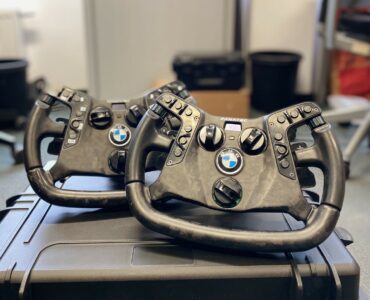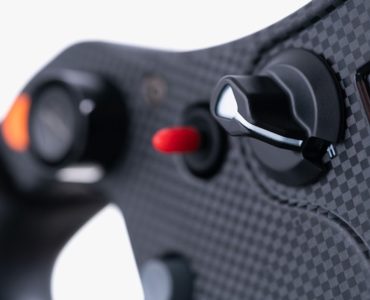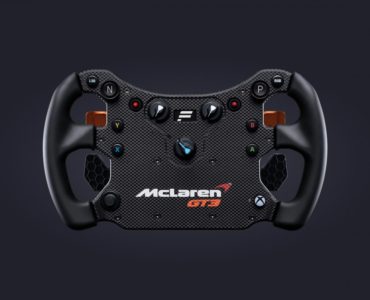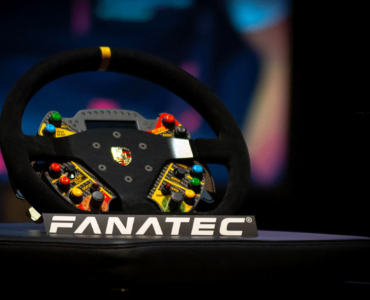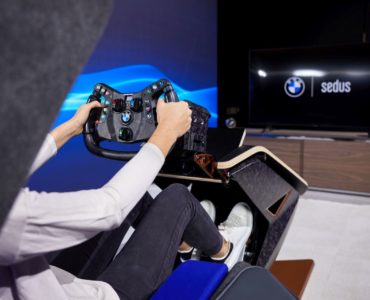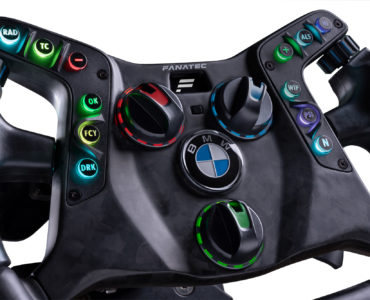Back in late 2008, Fanatec introduced the Porsche Clubsport Pedals, a fully aluminum-made pedal set equipped with advanced features such as a load cell brake and pedal vibration.
Three years later, Fanatec has revealed the CSR Elite Pedals that retain most of the bigger models??? features while selling for an even more competitive price.
Is switching to the CSR Elite Pedals worth the money compared to a standard pedal set? Read the review to find out!
[head3]Features[/head3]
The CSR Elite Pedals are a standalone pedal unit made almost fully of durable aluminum. The set comes with a standard three-pedal layout consisting of gas, brake & clutch.
The most important feature the CSR Elite pedals is the brake pedal that uses a load cell instead of a potentiometer like pedal sets from other mass-market manufacturers such as Logitech or Thrustmaster.
What may sound like a technicality to some actually completely changes your driving & braking experience but more on that later on.
Aside from the load-cell, the pedals comes with lots of other premium features such as full adjustability as users are as pedal position, angle and springs can be tweaked to the users liking.
Compared to its bigger brother the Porsche Club Sport Pedals, the Elites have lost a single feature and that???s brake pedal vibration which remains an exclusive feature of the top-shelf model.
Using an additional inversion kit, the CSR Elite pedals can even be inverted to simulate hanging pedals, a feature that was first introduced to the mass market by the Thrustmaster T500 RS.
[head3]Build Quality[/head3]Even though the CSR Elite Pedals sell for less than the Clubsport Pedals, Fanatec has cut no corners in terms of build quality as this is a piece of high-quality gear.
The pedals and the footrest are made of high-quality aluminum, giving the whole unit a very durable look and feel and resulting in an impressive weight.
Aside from some minor parts of the pedal mechanics, the only plastic used on the pedals regards the undertray that is used to hold the aluminum components together.
Even though the Clubsport pedals used no plastic at all and were fully made of aluminum, the plastic casing actually helps the CSR Elites with their positive impression. I reviewed the Clubsports back when they were brand new and some details like the wiring on the underside looked a bit rough around the edges.
As much as Fanatec has streamlined their products in terms of documentation & support since 2008, the CSR Elites feel like a much more rounded and finished product despite the plastic undertray and being the cheaper option.
The pedals can even be removed from the plastic undertray for those who wish to hard-mount them to a racing rig.
The durable materials definitely pay off in the long run as I??ve been using the pedals for quite a while and despite continued usage, the set still looks absolutely like new. These pedals are made to take a beating and won???t wear out due to the use of high quality sensors and the load cell.
[head3]Installation[/head3]This topic can be covered very briefly as the pedals are very easy to set up. On the PC, it???s only a matter of plugin the pedals into the USB port and get going. Since the CSR Elites lack the vibration feature of the Clubsports, there???s no need to install a driver as the pedals work fine with the standard input device driver.
The pedals are compatible to every simulation that supports a secondary controller device which applies to pretty much all titles released in the past 5-6 years, even mainstream titles like F1 2011 or DiRT 3 offer this kind of compatibility these days.
For console usage, the pedals only work with Fanatec wheels (excluding the 911 Turbo) as the pedals have to be plugged into the wheel. PC users of Fanatec wheels can theoretically use this method as well, using the USB connection should be preferred though as it uses the full 10bit resolution.
The only slight hiccup I ran into when setting up the pedals were the rubber stops on the bottom that proved to be completely ineffective on metal surfaces. I??m using the pedals together with the GTOmega rig and the pedals kept sliding around on the wheel plate.
The solution to this was rather simple as a pice of carpet put under the pedals stopped the sliding instantly as the rubber stops work effectively on carpet.
[head3]Driving Experience[/head3]With the pedals plugged in, it???s time to give them a try. Now we get to the point where the CSR Elite???s leapfrog the competition. It???s not the neat design or the durable materials but the load cell brake that set them apart from the competition.
Usual mass market pedal sets work with potentiometers, meaning the force of the brake is controlled by how far the pedal is being pushed. If you push it a little, little force is applied and full force isn???t applied until you push it to the metal.
This is the way pretty much every sim racer has learned to brake, even though it has little to with how the brake in a real car feels. The load cell brake changes this approach completely as the brake force is controlled by the amount of force applied to the pedal, not pedal movement.
At first, this takes a little to get used to as there???s very little movement and travel in the pedal as the brake is extremely stiff. After a while you get used to control the braking force by pressure as you can use muscle tension to dosage the brake.
It gets even better by the fact that the load cell is easily adjustable. Behind the brake pedal there???s a little dial that sets the amount of force needed to push the pedal to the max. While the brake is pretty loose on the lowest setting, it gets very stiff with the highest as you have to really slam down on the brake to apply maximum pressure.
This comes in really handy when driving cars with very sensible brakes that tend to lock up such as powerful open wheelers. With a bit of practice, the load cell brake is much easier to dosage as a potentiometer-powered brake without any additional fiddling or tricks like replacement springs, tennis balls or anything else that has been tried to improve the feel of regular pedal sets.
The gas & clutch pedals feel solid as well but the experience here doesn’t really differ that much from other pedal sets as the load cell brake is the one thing that sets the CSR Elite pedals apart.
[head3]Conclusion[/head3]Getting back to the initial question, are the CSR Elites worth the price difference compared to a normal pedal set? The answer is yes!
Whether you??re already using a Fanatec wheel or a competitor product from Logitech & Thrustmaster, the CSR Elite???s will vastly improve your sim experience as the load cell brake fundamentally changes the driving experience.
Once you??re used to this technology, going back to cheaper pedal sets will not be a satisfying experience anymore as the load cell brake really spoils you in terms of feeling & adjustability.
Luckily, there???s little reason to ever go back as the CSR Elite pedals are durable enough to last a lifetime and thanks to being completely independent from the used wheel (on the PC), they make up a perfect long-time companion.
The CSR Elites sell for 149 Euros/Dollars, 50 Euros/Dollars cheaper than the bigger Porsche Clubsport wheels. As described above, the only major difference is the lacking brake pedal vibration and given the fact that it only works on select simulations and is only realistic with ABS-equipped cars, I personally feel like this isn’t exactly a killer-feature you don???t want to miss out on.
In all other regards, the CSR Elites have improved on their predecessor, the result is a well-crafted and streamlined product made of quality materials that offers a technological advantage no other manufacturer is able to offer in this price range.
The CSR Elite pedals are exclusively available on the Fanatec Website
Pros:
[listpros]
- Made of durable aluminum
- No driver installation required
- Compatible to any steering wheel
- Adjustable load cell brake
[listcons]
- No brake pedal vibration







